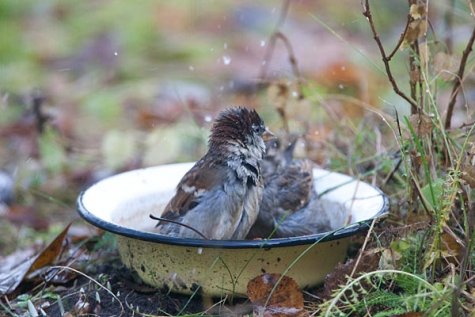Street urchin life before winter
Photo: Arne Ader
Translation: Liis
Autumn morning bath. House sparrows
House sparrow Koduvarblane Passer domesticus
The house sparrows are doubtless the best known and most wide-spread birds in the world. Where man has settled down in any numbers there the house sparrows feel at home too, but they are actually not very trusting towards people, with good cause. Smart, wary, with a street urchin’s cheeky behaviour, struggle out of all kinds of traps – even bird nets. Flight image is confident and straight-lined, and they sometimes keep company with domestic pigeons.
Modern life does not quite suit them: steel, glass, concrete. A village environment is the right place for sparrows. Cracks in the wooden panelling of houses, some broken window glasses in an attic, openings under the eaves, sheds and woodpiles in the yard, somewhat run-down home gardens ... and when victuals were brought to the small basement shops by horse transport on cobbled streets then life was perfect. Since that dreamtime sparrows have become much more scarce.
House sparrows look a little different compared to summertime – the plumage is a little paler and the sturdy blue-black beak of the summer is now yellowish-brown. After the moulting at the end of summer a watcher can no longer tell who is young and who is adult, but the sparrows themselves seem to know.
The house sparrow has a large head and short tail; length up to fifteen centimetres, weight around thirty grams. Male and female birds are easily distinguished by their plumage. Males have an ash grey crown and grey cheeks; across the eyes and cheek patch runs a reddish-brown semicircle. The throat is black, back brown with black lengthwise stripes, Wings brown with a whitish streak but that depends on the cleanliness of the individual (if the nights are spent in a warm chimney then the looks suffer somewhat).
The female’s plumage leaves an impression of grey; only the brow stripe is yellowish. Barely noticeable black streaks on the back; the wing band is narrow and cream-coloured.
The long and steadily cooler nights are often spent in pairs – if one has a mate. A nestbox or some other place offering shelter for the night is lined with material at hand. Such a winter home must be guarded, strangers with all kinds of plans move around and with them quarrels may start. Sparrows don’t give in easily to anyone.









